Wood turtles are a lot of fun to keep and to raise, as they are for the most part very tame and friendly.
The wood turtle (Clemmys insculpta) has been one of my favorites for years. This species is a lot of fun to keep and to raise, as they are for the most part very tame and friendly.
Read More
Indoor Tortoise And Turtle Table Housing
My childhood memories of walking through the open fields near the Muskegon River in Michigan as well as the Pocono Mountain region of Pennsylvania are captivated by the memories of this beautiful, gentle reptile, and in after spending many years living in their habitat I have learned much about them both in the wild as well as in captivity from raising them to maturity. In this article I'll pretty much limit the info to their captive care.

joe myers
Wood turtles are a lot of fun to keep and to raise, as they are for the most part very tame and friendly.
Finding this species on the market is still possible, but can be a bit pricey. Avoid buying wild-caught adults, since for one they're probably illegal, as well as probably unhealthy, and buying ANY wood turtle now from any state where they naturally occur is illegal. (Check your state for laws and permit processes) Mine came out of Florida and Texas many years ago from breeders that long since disappeared, and I strictly avoid mixing my captive collection with any from the wild (or even from another collection), since the risk of disease is just too high. It would be a tragedy to lose mine to an introduced disease, and even MORE tragic if a "wild" one was introduced to mine then later released, thus spreading some sort of "captive disease" to the wild population. I’t is good to remember to NEVER introduce any wild turtle to a captive population if you have plans on releasing it later, and again remember that introducing a wild one to your captive stock can wipe them out in less than a month. From experience I have learned to leave the wild ones strictly alone, and use them for photography subjects only, and leaving them right where they are.
Assuming you start yours as a hatchling, we'll start from the beginning. As babies they are fairly aquatic, but will spend a lot of time resting on land under a lamp, and like any reptile, trial and error will show you the best distance between the light source and your turtles, and once you get them feeding, the rest comes very easy. They will grow and grow! In the very beginning I will tempt them with a tiny piece of meat on the end of a broomstraw, and once they learn this means "food,”, I simply drop the small pieces into the water with them, and they will behave much like any water turtle. I feed them tiny earthworms, small crickets, mealworms, as well as Repto-Min. Soon you will literally have them running right up to you at feeding time. They will feed both on land as well as in the water.
Wood Turtle Enclosure
For the actual setup when they are small, I use a Rubbermaid-type container, and simply prop one end up to give them land and water, and mount the lamp over it. They will grow very fast, and from my own experience I have kept the light on them for 24 hours, and they will develop a natural cycle according to when you normally feed them. Sometimes they get so "into" this cycle they will refuse food altogether when fed at a time when they're normally not fed – but will gobble with great gusto when it's their time! I also have other species which were raised right alongside them, and they feed and do very well together.
When "power-fed" a male will mature in about three to four years, and in females about five, but add a year or two if fed regularly, and if chilled during the winter months, add another two years or so. Once they reach about five inches they can be kept either indoors or outdoors. Like all turtles, large ones are messy, You can rig a large tub with an indoor drain, to make cleanup easier. I placed mine outdoors, and they haven't been back inside ever since.
There are two main enemies to be concerned about, in fact, make it three! All will cost you your turtles if you're not careful. Raccoons, neighborhood kids, and disease. Coons will go in there at night and will easily drag them right over the fence, and even if the shell protects the turtle, it will crawl away later and probably end up drowned at the bottom of your neighbor's swimming pool or dead on the road. Also let NOBODY know you have them, since all it takes is one kid to know about them, and they will tell their friends, and just like with the raccoons, you will lose a couple a night, and you may not even notice it until it's too late. Also NEVER introduce yours to any other turtles, since disease will almost certainly put them out of commission permanently! Even so-called "healthy" stock will carry things that yours haven't been introduced to yet, and mixing them will easily cost their lives. As for me I live in the country and have a large piece of plastic under which they hide at night faithfully, and they are safe from coons, and by day I feed them on top of this, since this keeps the food off the dirty ground.
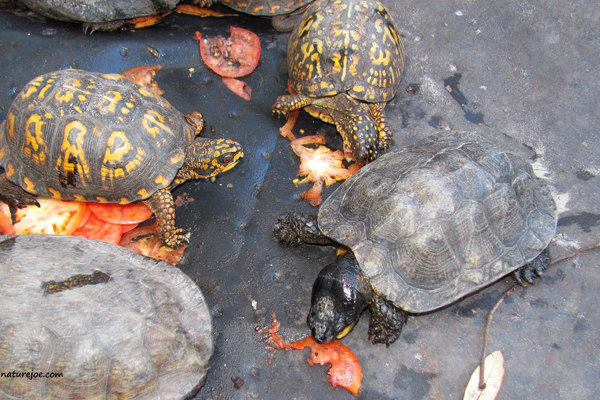
joe myers
Wood turtles are "best buddies" on dry land, but once in water the males become very territorial.
Mine live in a large, outdoor fenced enclosure, and they are experts at escaping. It's been a long time since mine have tried to do so, but when they do they will try climbing over, and if this doesn't work, they'll try going under! I bend the top of the fence inward to stop them from going over, and the fence is buried about six inches into the ground, but even then it's a good thing to look for holes left there by something else! I remember when I lived in Ohio I had a groundhog (Marmota monax) dig under once or twice, and here in Florida I have had a few "mystery" holes appear every now and then, so I'm always prompted to look.
Wood Turtle Food Choices
As far as feeding goes, mine have been raised to maturity on the following diet, and are all in tip-top shape and look just like their wild cousins. I feed the young ones raw 93-lean hamburger, and I mix a bit of oyster shell calcium powder as well as one of the commercial reptile vitamins such as RepCal, and I go very lightly on the mix, and Repto-Min, and when large enough they'll take Romaine lettuce, and cantaloupe, as well as bananas. A good staple food I use for them, and they grow and prosper on it is Purina Naturals cat food. I take a large bowl and pour the food in, and pour some Linatone over the pellets, shake until well-coated, and feed them on the plastic, and they will gather and feed promptly. My adults will graze on plants growing naturally in their enclosure, but crave dandelion greens, Bidens, and other plants that aren't too "spicy" or fuzzy for them. Also tomatoes are favored by them, as well as apples, and when feeding apples, it's best to simply place the apple on the ground and crush it underfoot! They can't bite into apple slices too well.
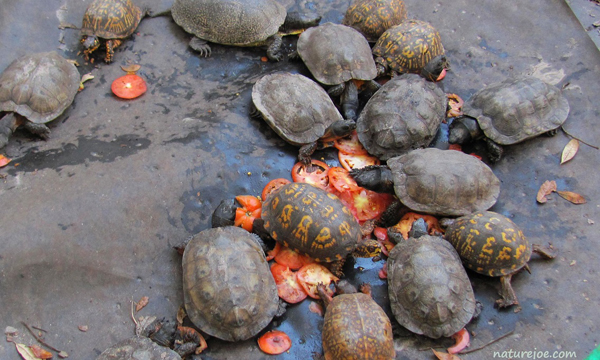
joe myers
Tomatoes are favored by wood turtles as well as apples.
Wood turtles are mainly vegetarians as adults, and care for mine as such, but in the spring I will "beef them up" by several feedings of the hamburger until warm weather dominates, then once they eat regularly I decrease the meat after egg-laying and they get the Purina Natural cat food about twice a week, and a variety of veggies daily. I always try and keep some sort of fruit out there for them, but I never allow food to remain in there overnight to avoid predation. As for water I use a large shallow sturdy Rubbermaid-type container for them, and I never fill it more than five to six inches, since a male will crawl in there and drown another one if the water is much deeper than that. Also if you keep more than one or two males you're asking for trouble. They are "best buddies" on dry land, but once in water the males become very territorial, and fights will be common if you have one too many males. I have even seen females take a snap or two at each other in the water. but I have never seen any injury from this.
Wood Turtle Breeding
Breeding also takes place in the water, and for this I place a pair in water about a foot deep or less and watch them closely. The male will immediately mount the female and will court her for a length of time. Every "courting" does not result in a mating. For best results I pick a cool day following hot weather, and mating is more likely. The activity must be supervised for signs of distress, because he will very easily drown your female, and I have lost a dozen or so females over the years from this, and now I won't let them out of my sight. The actual copulation lasts about an hour or so, and once they're firmly "connected" I lift the pair out of the deeper water and place them into a shallow container with water of the same temperature, and away from other turtles. I move them so the female can get some much-needed air during the ordeal. It does not bother them at all when a
courting/copulating pair is moved from one container to another, and can be done so as needed.
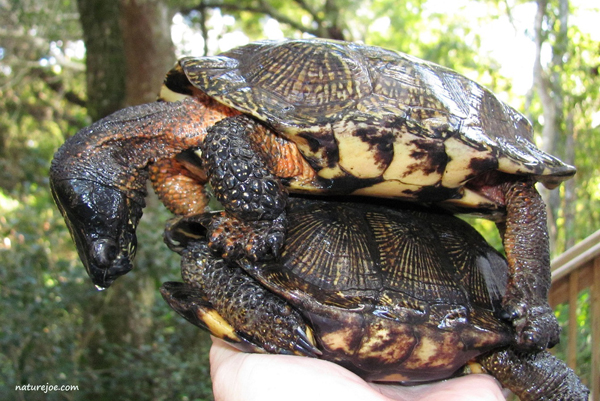
joe myers
It does not bother them at all when a courting/copulating pair is moved from one container to another.
Here in Florida the eggs are laid between late-March and late-April, and the Florida sun seems to be a bit strong for them, so I hatch them indoors in plastic containers. Nesting occurs around sundown usually, but sometimes in the mornings, or during a sudden storm during any daylight hour. They hide their nest quite well, and if I don't see them digging the hole, I may never find the eggs. Moles and shrews find them very quickly here, and the eggs are often eaten just as the female covers them.
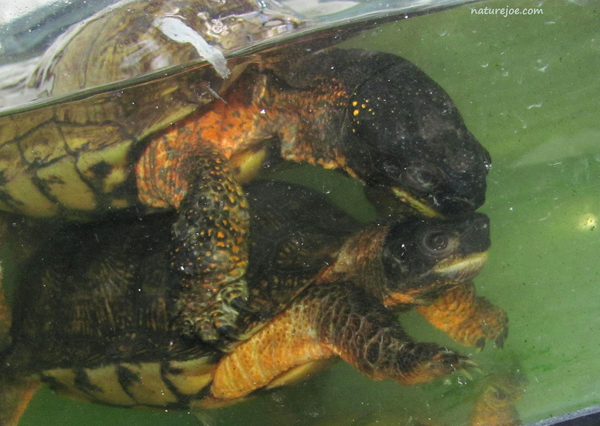
joe myers
Wood turtles also breed in water.
When raising them indoors you are assured a perfectly healthy and flawless collection that may just outlive you, and outdoors you'll get some offspring, and again remember the risks. Also most "Woodies" will lay their eggs once a year, but it's not uncommon for some to produce a second set of eggs less than a month later. Also once they reach adult size brumation seems to be best for them – providing they have experienced the summer outside. If you're keeping them indoors and they have never seen the light of the sun, they can be kept going with no problem, but to brumate them it's best to leave them outdoors until the leaves drop, and pile the leaves up so they can burrow beneath them. Before really cold weather arrives bring them indoors and put them into a shallow container of water in a dark, cool basement, and they'll sleep the winter away! The best place is a basement that is allowed to remain unheated in the winter, and with temperatures in the upper-40's and 50’s. They will sleep comfortably until April.
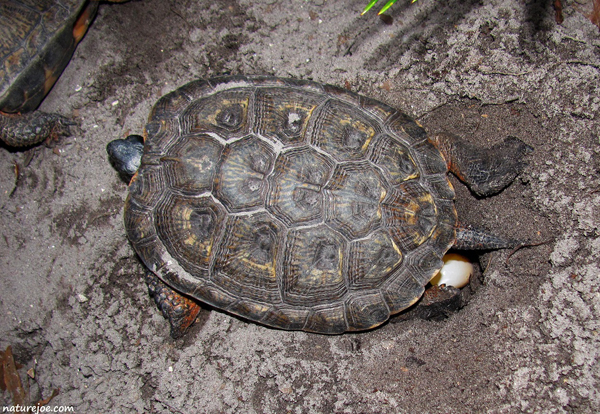
joe myers
A wood turtle depositing her eggs.
Here in Florida I never bring them in, and beneath their sheet of plastic they will spend their nights, and throughout the winter they emerge in the morning sun to bask awhile and to get a drink, and by choice some will enter the water container and will use it instead of the plastic cover, but a warm sunny day will always bring them forth. Keeping wood turtles pretty much depends upon their winter care, and "wintering" them successfully will assure decades of joy with these amazing creatures. They will dazzle you with their intelligence and will literally come running to you at feeding time. There are so many things I could share about these from the 30 years of experience I have had in keeping them as a part of my family. I will do a "Herping" article on the wood turtle in the near future to see their wild side, and if you do find these on a list I promise you won't be disappointed with these, as they add a bit of "personality" to the world of turtles.
"Nature" Joe (Myers) is a nature photographer, and has been keeping Wood turtles and others since the late-1970's, and working with groups of people of all ages in an outdoor educational setting since 1986, and can be followed on Facebook https://www.facebook.com/n.joe.myers where his nature photography and time-lapse videos can be seen publicly.


